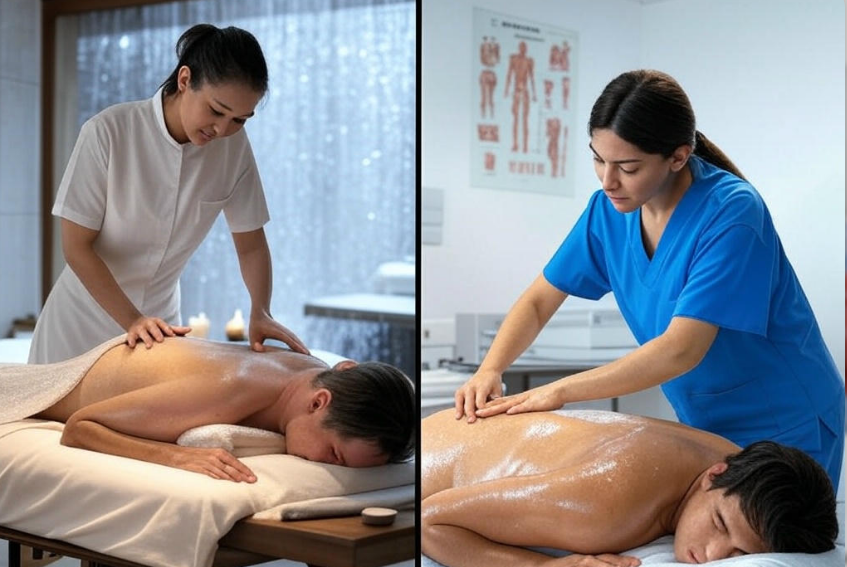Have you ever felt lost when deciding between a massage for nagging back pain or one to simply unwind after a tough week? You’re not alone—research indicates that over 60% of people seeking massages have specific goals in mind, yet many don’t know whether to choose registered massage therapy (RMT) or a spa massage, leading to mismatched expectations. This article dives into the difference between RMT and spa massages, offering a detailed look at their purposes, methods, and outcomes to guide you toward the right choice. Keep reading to learn how to ensure your next massage delivers exactly what you’re looking for!
What’s the Real Difference Between RMT and Spa Massages?
On the surface, massages might appear to be a universal experience—just a pair of hands working out your tension—but the reality is far more nuanced. The difference between RMT and spa massages lies in their foundational approaches, from the training behind them to the environments they’re offered in. To understand which suits you best, it’s worth exploring what each one truly involves.
What Is Registered Massage Therapy (RMT)?
Registered massage therapy is a regulated healthcare practice carried out by professionals known as registered massage therapists, who undergo extensive training—typically over 2,200 hours—covering subjects like human anatomy, physiology, pathology, and advanced clinical techniques. Their primary focus is therapeutic massage, which means they aim to address specific physical conditions such as chronic lower back pain, muscle stiffness from poor posture, or rehabilitation after a car accident. These sessions usually take place in clinical settings like physiotherapy offices or private treatment rooms, though some RMTs also provide services in spas under a therapeutic framework.
What Are Spa Massages?
Spa massages, in contrast, are centered around relaxation and indulgence, offering a sensory escape rather than a medical solution. The practitioners delivering these massages often have less formal training—sometimes as little as 100 to 500 hours—focused on basic relaxation techniques, and their qualifications aren’t regulated like those of RMTs. You’ll find spa massages in upscale wellness centers or resorts, where the experience is enhanced with calming elements like soft ambient music, dim lighting, scented candles, and plush surroundings, all designed to melt away stress.
How Does RMT Differ in Training and Expertise?
One of the most significant aspects of the difference between RMT and spa massages is the level of training and expertise involved, which directly impacts what each can achieve. This distinction shapes not only the skills of the practitioners but also the trust you can place in their abilities. Let’s examine how their preparation sets them apart.
RMT: Rigorous and Regulated Education
Registered massage therapists commit to a rigorous educational journey, often lasting 2 to 3 years, that includes in-depth coursework and hands-on practice in a supervised setting, culminating in certification exams overseen by regulatory bodies. They master complex topics like musculoskeletal anatomy, nerve function, and therapeutic methods—think deep tissue massage to break up scar tissue or joint mobilization to restore range of motion. This expertise equips them to conduct detailed assessments, such as identifying a tight IT band causing knee pain, and to craft personalized treatment plans that deliver measurable health improvements.
Spa Massage: Variable and Less Formal Training
Spa massage practitioners, on the other hand, typically complete shorter, less standardized training programs that might range from a few weeks to several months, focusing on foundational techniques like Swedish massage or the use of hot stones. Since their training isn’t regulated, the depth of their knowledge can vary widely—some may excel in relaxation methods, while others have only basic skills. Their preparation is geared toward providing a pleasant, general experience rather than diagnosing or treating specific medical conditions, making them ideal for wellness but not for clinical needs.
What Sets Techniques and Focus Apart?
The techniques employed and the goals they serve further highlight the difference between RMT and spa massages, as each targets a distinct outcome. Whether you need relief from a physical ailment or a break from mental strain, the approach matters. Here’s how they diverge in practice.
RMT: Targeted, Clinical Techniques
RMTs use a repertoire of precise, often intense techniques tailored to address specific health concerns, such as trigger point therapy to release tight muscle knots, myofascial release to ease restrictive connective tissue, or deep tissue massage to penetrate layers of muscle and fascia. Their focus is clinical—think reducing inflammation in a strained shoulder, improving posture after long desk hours, or speeding recovery from a sports injury like a hamstring tear. While these sessions might involve some discomfort due to the depth of work, the result is often significant pain reduction and enhanced physical function, as supported by a 2021 Journal of Physiotherapy study showing massage therapy benefits like a 30% decrease in chronic pain.
Spa Massage: Gentle, Soothing Strokes
Spa massages take a softer approach, employing flowing, light techniques like effleurage (long, gliding strokes), petrissage (kneading), or the application of warm stones and aromatic oils to create a calming, full-body experience. The emphasis is on relaxation and stress relief, not on resolving underlying physical issues—so while you might feel looser after a session, it’s not designed to fix a pinched nerve or chronic tension. A 2020 wellness study found that relaxation massage can reduce anxiety by 25%, making it a powerful tool for mental well-being and a restful night’s sleep.
How Do Settings and Costs Compare?
The environment you step into and the financial aspect of your massage experience also reveal key differences between RMT and spa massages. These elements affect not just your comfort but also your wallet. Let’s break down how they stack up.
RMT: Clinical Settings and Insurance Options
RMT sessions are typically held in practical, no-frills spaces like physiotherapy clinics, chiropractic offices, or private treatment rooms, where the focus is on functionality rather than aesthetics—think a clean table, bright lighting, and minimal decor. Costs generally fall between $80 and $120 per hour, but a major advantage is that many health insurance plans recognize RMT as a reimbursable healthcare service, often covering part or all of the fee depending on your policy. After a session, you might leave with a tailored stretching routine or advice to complement the treatment, adding value beyond the massage itself.
Spa Massage: Luxurious Ambiance and Out-of-Pocket Fees
Spa massages unfold in carefully curated environments designed to pamper—think plush robes, warm towels, flickering candles, and tranquil music that instantly signals relaxation. Prices can range from $50 to $150 per hour, influenced by the spa’s location, reputation, and added perks like a sauna or champagne, but they’re almost never covered by insurance, and tipping (often 15–20%) is customary, increasing the total cost. You’re paying for an experience as much as the massage, which might last 50 to 120 minutes depending on the package you choose.
| Aspect | RMT | Spa Massage |
|---|---|---|
| Training | 2,200+ hours, regulated, certified | 100–500 hours, unregulated, variable |
| Focus | Therapeutic, health improvement | Relaxation, stress relief |
| Techniques | Deep tissue, trigger point, clinical | Swedish, hot stone, light strokes |
| Setting | Clinical, functional | Luxurious, sensory-focused |
| Cost | $80–$120/hour, often insured | $50–$150/hour, out-of-pocket + tip |
| Assessment | Detailed intake, personalized plan | Minimal, pre-set menu options |
| Duration | 30–90 minutes, goal-specific | 50–120 minutes, experience-based |
| Outcome | Pain relief, mobility improvement | Calmness, mood enhancement |
Which Massage Suits Your Needs: RMT or Spa?
Deciding between RMT and spa massages hinges on what you hope to achieve—whether it’s healing a physical problem or soothing a frazzled mind. Both have their strengths, but they shine in different scenarios. Here’s a detailed guide to help you choose.
When RMT Is the Better Choice
RMT is ideal if you’re dealing with a specific health issue, such as persistent lower back pain from sitting all day, a pulled muscle from a workout, or stiffness following surgery that requires therapeutic massage to restore function. It’s also a smart pick if you have insurance coverage—many plans offset the $80–$120 hourly cost, making it cost-effective for regular treatments. For example, Jane, a 42-year-old runner, visited an RMT for knee pain caused by tight calves; after a few sessions of targeted deep tissue work, she was back to her weekly runs with reduced discomfort.
Tip: Bring notes about your symptoms or past injuries to your RMT—they’ll use this to tailor the session for maximum impact.
When Spa Massage Fits Best
Spa massages are perfect when your goal is to de-stress, recharge, or simply treat yourself to a moment of calm, offering relaxation massage that eases mental tension without tackling physical ailments. They’re great for beginners wary of intense pressure or for special occasions—think a birthday gift or a weekend retreat—since spas often bundle massages with extras like facials or steam rooms. Mark, a busy parent, swears by his monthly spa visits, where a 60-minute session with lavender oil and hot stones leaves him refreshed and ready to tackle his hectic schedule.
Example: Booking a couples’ massage with soothing music could elevate a romantic evening.
Benefits Breakdown
- RMT Benefits: Reduces chronic pain by 30% (2021 Journal of Physiotherapy), accelerates injury recovery (e.g., tendonitis), lowers stress hormones like cortisol as a secondary perk.
- Spa Benefits: Decreases anxiety by 25% (2020 wellness study), boosts serotonin for better sleep, lifts your mood through a pampered experience.
Sum Up
The difference between RMT and spa massages is clear when you look at the details: RMT brings clinical expertise with intensive training, targeted techniques, and insurance-friendly costs to heal your body, while spa massages offer a luxurious retreat with gentle methods and a focus on mental calm. Whether you need therapeutic massage to tackle a sore neck or relaxation massage to escape daily pressures, understanding these distinctions ensures you get the outcome you’re after. With RMT, you invest in health; with spa massages, you invest in peace—so which do you need most right now? Take a moment to decide, then book your next session to feel the difference for yourself!









